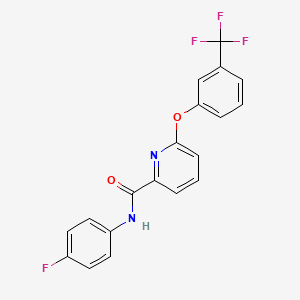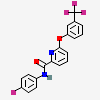Picolinafen
- Picolinafen
- 137641-05-5
- Picolinafen [ISO]
- UNII-VJE2EX3SNN
- VJE2EX3SNN
- Create:2005-09-06
- Modify:2025-01-18

- Picolinafen
- 137641-05-5
- Picolinafen [ISO]
- UNII-VJE2EX3SNN
- VJE2EX3SNN
- picolinafene
- N-(4-fluorophenyl)-6-[3-(trifluoromethyl)phenoxy]pyridine-2-carboxamide
- PICOLINAFEN [MI]
- DTXSID8044339
- CHEBI:138736
- N-(4-Fluorophenyl)-6-[3-(trifluoromethyl)phenoxy]-2-pyridinecarboxamide
- 4'-fluoro-6-(alpha,alpha,alpha-trifluoro-m-tolyloxy)pyridine-2-carboxanilide
- 4'-FLUORO-6-(.ALPHA.,.ALPHA.,.ALPHA.-TRIFLUORO-M-TOLYLOXY)PYRIDINE-2-CARBOXANILIDE
- N-(4-fluorophenyl)-6-(3-(trifluoromethyl)phenoxy)pyridine-2-carboxamide
- N-(4-FLUOROPHENYL)-6-(3-(TRIFLUOROMETHYL)PHENOXY)-2-PYRIDINECARBOXAMIDE
- Picolinafen 10 microg/mL in Cyclohexane
- Picolinafen 10 microg/mL in Acetonitrile
- SCHEMBL54805
- DTXCID6024339
- AS-85646
- NS00009710
- Picolinafen, PESTANAL(R), analytical standard
- J-007048
- Q2092340
- N-(4-Fluorophenyl)-6-(3-(trifluoromethyl)phenoxy)picolinamide
- 2-Pyridinecarboxamide, N-(4-fluorophenyl)-6-[3-(trifluoromethyl)phenoxy]-
- N-(4-Fluorophenyl)-6-[3-(trifluoromethyl)phenoxy]-pyridine-2-carboxamide
- N-(4-Fluorophenyl)-6-(alpha,alpha,alpha-trifluoro-m-tolyloxy)picolinamide, N-(4-Fluorophenyl)-6-[3-(trifluoromethyl)phenoxy]-2-pyridinecarboxamide
377.0917 999
378.0948 155
379.0967 17
284.0528 14
359.0803 12
377.0916 999
256.0582 991
284.0533 610
359.0808 604
378.0944 188

H400 (100%): Very toxic to aquatic life [Warning Hazardous to the aquatic environment, acute hazard]
H410 (100%): Very toxic to aquatic life with long lasting effects [Warning Hazardous to the aquatic environment, long-term hazard]
P273, P391, and P501
(The corresponding statement to each P-code can be found at the GHS Classification page.)
Aggregated GHS information provided per 182 reports by companies from 4 notifications to the ECHA C&L Inventory. Each notification may be associated with multiple companies.
Information may vary between notifications depending on impurities, additives, and other factors. The percentage value in parenthesis indicates the notified classification ratio from companies that provide hazard codes. Only hazard codes with percentage values above 10% are shown.
Aquatic Acute 1 (100%)
Aquatic Chronic 1 (100%)
STOT RE 2
Aquatic Acute 1
Aquatic Chronic 1
Patents are available for this chemical structure:
https://patentscope.wipo.int/search/en/result.jsf?inchikey=CWKFPEBMTGKLKX-UHFFFAOYSA-N
- CAS Common ChemistryLICENSEThe data from CAS Common Chemistry is provided under a CC-BY-NC 4.0 license, unless otherwise stated.https://creativecommons.org/licenses/by-nc/4.0/
- ChemIDplusChemIDplus Chemical Information Classificationhttps://pubchem.ncbi.nlm.nih.gov/source/ChemIDplus
- EPA DSSToxCompTox Chemicals Dashboard Chemical Listshttps://comptox.epa.gov/dashboard/chemical-lists/
- European Chemicals Agency (ECHA)LICENSEUse of the information, documents and data from the ECHA website is subject to the terms and conditions of this Legal Notice, and subject to other binding limitations provided for under applicable law, the information, documents and data made available on the ECHA website may be reproduced, distributed and/or used, totally or in part, for non-commercial purposes provided that ECHA is acknowledged as the source: "Source: European Chemicals Agency, http://echa.europa.eu/". Such acknowledgement must be included in each copy of the material. ECHA permits and encourages organisations and individuals to create links to the ECHA website under the following cumulative conditions: Links can only be made to webpages that provide a link to the Legal Notice page.https://echa.europa.eu/web/guest/legal-noticepicolinafen (ISO); N-(4-fluorophenyl)-6-[3-(trifluoromethyl)phenoxy]pyridine-2-carboxamide; 4′-fluoro-6-[(α,α,α-trifluoro-m-tolyl)oxy]picolinanilidehttps://echa.europa.eu/substance-information/-/substanceinfo/100.112.657[No public or meaningful name is available]https://echa.europa.eu/substance-information/-/substanceinfo/100.167.582picolinafen (ISO); N-(4-fluorophenyl)-6-[3-(trifluoromethyl)phenoxy]pyridine-2-carboxamide; 4′-fluoro-6-[(α,α,α-trifluoro-m-tolyl)oxy]picolinanilide (EC: 604-030-0)https://echa.europa.eu/information-on-chemicals/cl-inventory-database/-/discli/details/31269
- FDA Global Substance Registration System (GSRS)LICENSEUnless otherwise noted, the contents of the FDA website (www.fda.gov), both text and graphics, are not copyrighted. They are in the public domain and may be republished, reprinted and otherwise used freely by anyone without the need to obtain permission from FDA. Credit to the U.S. Food and Drug Administration as the source is appreciated but not required.https://www.fda.gov/about-fda/about-website/website-policies#linking
- ChEBI
- EU Pesticides Database
- NORMAN Suspect List ExchangeLICENSEData: CC-BY 4.0; Code (hosted by ECI, LCSB): Artistic-2.0https://creativecommons.org/licenses/by/4.0/picolinafenNORMAN Suspect List Exchange Classificationhttps://www.norman-network.com/nds/SLE/
- USDA Pesticide Data ProgramPicolinafenhttps://www.ams.usda.gov/datasets/pdp
- Regulation (EC) No 1272/2008 of the European Parliament and of the CouncilLICENSEThe copyright for the editorial content of this source, the summaries of EU legislation and the consolidated texts, which is owned by the EU, is licensed under the Creative Commons Attribution 4.0 International licence.https://eur-lex.europa.eu/content/legal-notice/legal-notice.htmlpicolinafen (ISO);...https://eur-lex.europa.eu/eli/reg/2008/1272/oj
- Japan Chemical Substance Dictionary (Nikkaji)
- MassBank Europe
- MassBank of North America (MoNA)LICENSEThe content of the MoNA database is licensed under CC BY 4.0.https://mona.fiehnlab.ucdavis.edu/documentation/license
- NIST Mass Spectrometry Data CenterLICENSEData covered by the Standard Reference Data Act of 1968 as amended.https://www.nist.gov/srd/public-lawPicolinafenhttp://www.nist.gov/srd/nist1a.cfm
- SpectraBasePicolinafenhttps://spectrabase.com/spectrum/EkjI1KxzCwhPicolinafenhttps://spectrabase.com/spectrum/FgkVKWNIYBC
- Springer Nature
- Wikidatapicolinafenhttps://www.wikidata.org/wiki/Q2092340
- Wiley
- PubChemPFAS and Fluorinated Compounds in PubChemhttps://gitlab.com/uniluxembourg/lcsb/eci/pubchem-docs/-/raw/main/pfas-tree/PFAS_Tree.pdf?inline=false
- GHS Classification (UNECE)GHS Classification Treehttp://www.unece.org/trans/danger/publi/ghs/ghs_welcome_e.html
- EPA Substance Registry ServicesEPA SRS List Classificationhttps://sor.epa.gov/sor_internet/registry/substreg/LandingPage.do
- MolGenieMolGenie Organic Chemistry Ontologyhttps://github.com/MolGenie/ontology/
- PATENTSCOPE (WIPO)SID 389186799https://pubchem.ncbi.nlm.nih.gov/substance/389186799




